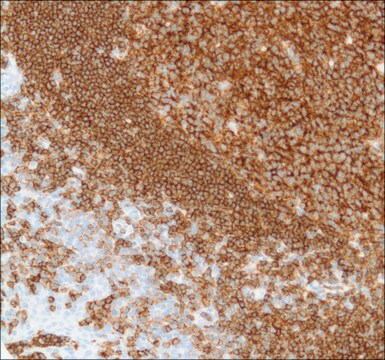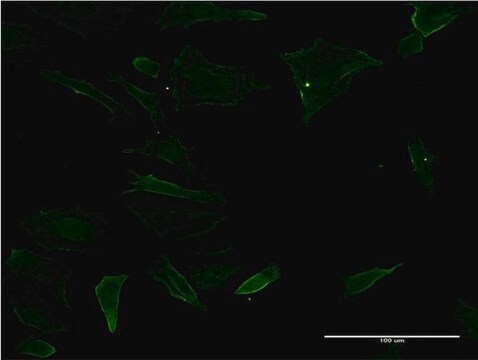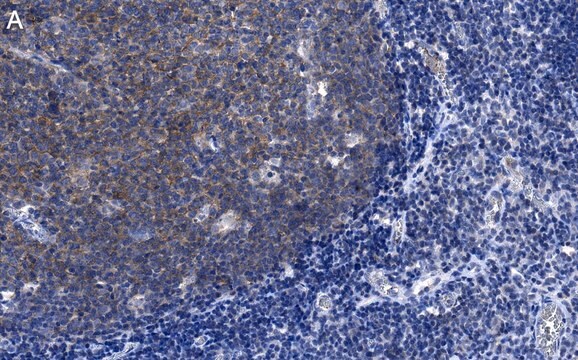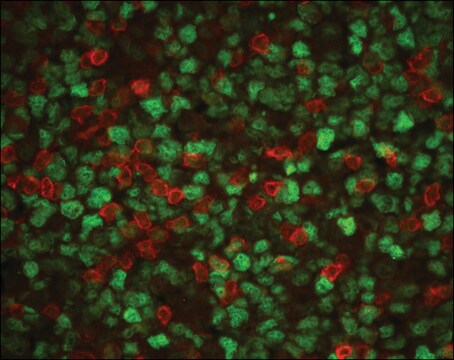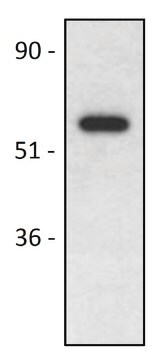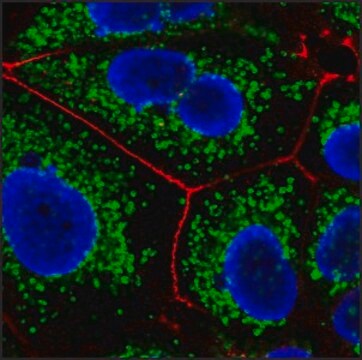SAB4700108
Monoclonal Anti-CD19 antibody produced in mouse
clone 4G7, purified immunoglobulin, buffered aqueous solution
Faça loginpara ver os preços organizacionais e de contrato
About This Item
Código UNSPSC:
12352203
NACRES:
NA.41
Produtos recomendados
fonte biológica
mouse
Nível de qualidade
conjugado
unconjugated
forma do anticorpo
purified immunoglobulin
tipo de produto de anticorpo
primary antibodies
clone
4G7, monoclonal
Formulário
buffered aqueous solution
reatividade de espécies
human
técnica(s)
flow cytometry: suitable
Isotipo
IgG1
nº de adesão NCBI
nº de adesão UniProt
Condições de expedição
wet ice
temperatura de armazenamento
2-8°C
modificação pós-traducional do alvo
unmodified
Informações sobre genes
human ... CD19(930)
Descrição geral
CD19 (cluster of differentiation 19) is a 95kDa protein localized on the surface of nearly all B lymphocytes and is considered to be the specific surface marker for B cells.This protein belongs to the immunoglobulin (Ig) superfamily with a cytoplasmic region of ∼240 amino acids and is involved in the regulation of B cell function.The protein is encoded by the 7.41kb cd19 gene, mapped on the short arm of human chromosome 16p11.2. There are certain localized regions of strong net negative charges with nine tyrosine residues in the cytoplasmic region of CD19. These regions might regulate the interaction of CD19 with the proto-oncogene Vav, phosphatidylinositol-3 kinase (PI-3 kinase) and the Lyn, Lck and Fyn protein tyrosine kinases.
Imunogênio
Human CCL (chronic lymphocytic leukemia) cells
Aplicação
The reagent is designed for Flow Cytometry analysis. Suggested working dilution is 1 μg/mL of sample. Indicated dilution is recommended starting point for use of this product. Working concentrations should be determined by the investigator.
Ações bioquímicas/fisiológicas
CD19 (cluster of differentiation 19) expression is restricted to normal and malignant B-lineage cells. Therefore, it is considered to be a striking target for immunotherapies aimed at B-cell malignancies. CD19 helps B lymphocytes to initiate primary immune response even at low concentrations of antigen.The encoded protein plays a crucial role in initiating intrinsic B cell signaling thresholds by regulating both B cell receptor (BCR)-dependent and independent signaling. It also functions as a biomarker for B-cell development.
Características e benefícios
Evaluate our antibodies with complete peace of mind. If the antibody does not perform in your application, we will issue a full credit or replacement antibody. Learn more.
forma física
Solution in phosphate buffered saline, pH 7.4, with 15 mM sodium azide.
Exoneração de responsabilidade
Unless otherwise stated in our catalog or other company documentation accompanying the product(s), our products are intended for research use only and are not to be used for any other purpose, which includes but is not limited to, unauthorized commercial uses, in vitro diagnostic uses, ex vivo or in vivo therapeutic uses or any type of consumption or application to humans or animals.
Não está encontrando o produto certo?
Experimente o nosso Ferramenta de seleção de produtos.
Código de classe de armazenamento
10 - Combustible liquids
Ponto de fulgor (°F)
Not applicable
Ponto de fulgor (°C)
Not applicable
Escolha uma das versões mais recentes:
Já possui este produto?
Encontre a documentação dos produtos que você adquiriu recentemente na biblioteca de documentos.
The CD19/CR2/TAPA-1 complex of B lymphocytes: linking natural to acquired immunity.
Fearon DT and Carter RH.
Annual Review of Immunology, 127-149 (1995)
CD19: a biomarker for B cell development, lymphoma diagnosis and therapy.
Wang K
Experimental Hematology & Oncology, 1 (2012)
The CD19/CD21 signal transducing complex of human B lymphocytes includes the target of antiproliferative antibody-1 and Leu-13 molecules.
Bradbury LE
Journal of Immunology, 149, 2841-2850 (1992)
CD19 monoclonal antibody HD37 inhibits anti-immunoglobulin-induced B cell activation and proliferation.
Pezzutto A
Journal of Immunology, 138, 2793-2799 (1987)
Yan Hu et al.
EMBO reports, 22(7), e52481-e52481 (2021-06-15)
Receptor activator of NF-κB ligand (RANKL) is essential for osteoclast formation and bone remodeling. Nevertheless, the cellular source of RANKL for osteoclastogenesis has not been fully uncovered. Different from peripheral adipose tissue, bone marrow (BM) adipose lineage cells originate from
Nossa equipe de cientistas tem experiência em todas as áreas de pesquisa, incluindo Life Sciences, ciência de materiais, síntese química, cromatografia, química analítica e muitas outras.
Entre em contato com a assistência técnica